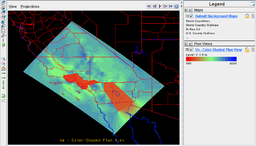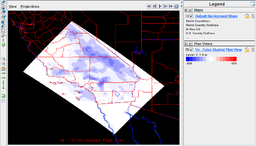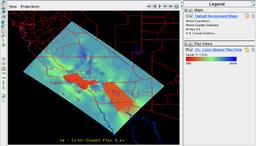Difference between revisions of "CVM-SI"
| Line 15: | Line 15: | ||
The map projection is a UTM zone 11 projection. The velocity model is C/Fortran code and associated files that are downloaded, compiled, and run locally. The user queries the models by creating an input file of latitude, longitude, and depth values, and the model returns Vp, Vs, and density at each of those points. | The map projection is a UTM zone 11 projection. The velocity model is C/Fortran code and associated files that are downloaded, compiled, and run locally. The user queries the models by creating an input file of latitude, longitude, and depth values, and the model returns Vp, Vs, and density at each of those points. | ||
This improved model has been imported into UCVM and is referenced with the model label "cvmsi". | This improved model has been imported into UCVM and is referenced with the model label "cvmsi". | ||
| + | |||
| + | == Iteration 20 Perturbations == | ||
| + | |||
| + | Good day! I have uploaded the VP and VP perturbation results to the USC computer under: | ||
| + | |||
| + | /auto/rcf-104/pochen/SC_F3DT_dV_SI20/ | ||
| + | |||
| + | The perturbations are separated into few files: | ||
| + | |||
| + | CVM4SI20_dV_# : # from 001~100 for perturbations at different depths | ||
| + | |||
| + | The file format is: | ||
| + | |||
| + | column 1: X | ||
| + | column 2: Y | ||
| + | column 3: Z | ||
| + | column 4: longitude | ||
| + | column 5: latitude | ||
| + | column 6: depth (m) ; 0 is surface | ||
| + | column 7: dVP (m/sec) ; VP of CVM4SI20 - VP of CVM4 | ||
| + | column 8: dVS (m/sec) ; VS of CVM4SI20 - VS of CVM4 | ||
| + | |||
| + | I attached a figure of waveform comparisons for Chino Hills event. In the figure, the black lines are data waveforms and the red lines are synthetic waveforms generated based on our current model. | ||
| + | We have applied a six-pole Butterworth filter with corners at 0.02 and 0.2 Hz to both waveforms. | ||
| + | |||
| + | Po and I would like to run few more iterations by using the scattering-integral and LSQR algorithms on the Mira. We will let you know, once we have a new model. | ||
| + | |||
== Iteration 8 == | == Iteration 8 == | ||
Revision as of 19:52, 21 February 2013
Contents
Overview
CVM-SCEC Improved (CVM-SI), is a 3D seismic velocity model based upon CVM-S with changes. Perturbations have been applied to this model as a result of iterations of inversion simulations by Chen et al (2011) and Lee et al (2010). The model is expressed as a 3D grid of 1536 x 992 x 100 cells with a grid spacing of 500 m. Query points are smoothed by interpolating the surrounding eight grid points. The four corners of the model region are:
-116.00000000000000 30.449999999999999 -122.30000000000000 34.783499999999997 -118.94748257396012 38.303452459152524 -112.51822905852465 33.781862621842393 -116.00000000000000 30.449999999999999
The map projection is a UTM zone 11 projection. The velocity model is C/Fortran code and associated files that are downloaded, compiled, and run locally. The user queries the models by creating an input file of latitude, longitude, and depth values, and the model returns Vp, Vs, and density at each of those points. This improved model has been imported into UCVM and is referenced with the model label "cvmsi".
Iteration 20 Perturbations
Good day! I have uploaded the VP and VP perturbation results to the USC computer under:
/auto/rcf-104/pochen/SC_F3DT_dV_SI20/
The perturbations are separated into few files:
CVM4SI20_dV_# : # from 001~100 for perturbations at different depths
The file format is:
column 1: X column 2: Y column 3: Z column 4: longitude column 5: latitude column 6: depth (m) ; 0 is surface column 7: dVP (m/sec) ; VP of CVM4SI20 - VP of CVM4 column 8: dVS (m/sec) ; VS of CVM4SI20 - VS of CVM4
I attached a figure of waveform comparisons for Chino Hills event. In the figure, the black lines are data waveforms and the red lines are synthetic waveforms generated based on our current model. We have applied a six-pole Butterworth filter with corners at 0.02 and 0.2 Hz to both waveforms.
Po and I would like to run few more iterations by using the scattering-integral and LSQR algorithms on the Mira. We will let you know, once we have a new model.
Iteration 8
The latest version of this model is iteration 8. Map and profile plots of version I5.
Differences with CVM-S4
The plots at right show a difference map of i5 - i0, followed by a plot of the starting model, i0, for reference. 3D meshes of the entire CVM-S/CVM-SI region has been extracted at 2km resolution into netCDF format in the "CF" convention:
- CVM-SI i5 : i5 mesh file (25MB)
- CVM-SI i0 (Starting model) : i0 mesh file (25MB)
- CVM-SI i5-i0 (difference): difference mesh file (25MB)
These meshes may be viewed in IDV (See the IDV Tutorial). The difference plot uses a custom color table which may be downloaded from Velocity Difference Color Table and imported into IDV.
Download CVM-SI
CVM-SI may be checked out from SVN with these commands:
svn co https://source.usc.edu/svn/cvmsi/trunk
An unofficial distribution is available for download here UCVM.
References
- Lee, E., Chen, P., Jordan, T., & Wang, L., 2011. Rapid full‐wave centroid moment tensor (CMT) inversion in a three‐dimensional earth structure model for earthquakes in Southern California, Geophysical Journal International, 186, 311–330.
- Chen, P., Lee, E., Jordan, T. H., Maechling, P. J., Denolle, M., & Beroza, G. C., 2011, Full-3D Waveform Tomography for Southern California, 2011 SSA Annual Meeting, Memphis, TN
- Lee, E., Chen, P., Jordan, T. H., Maechling, P. J., Denolle, M., & Beroza, G. C., 2010, Full-3D Waveform Tomography for Southern California, 2010 AGU Fall Meeting, San Francisco, CA


